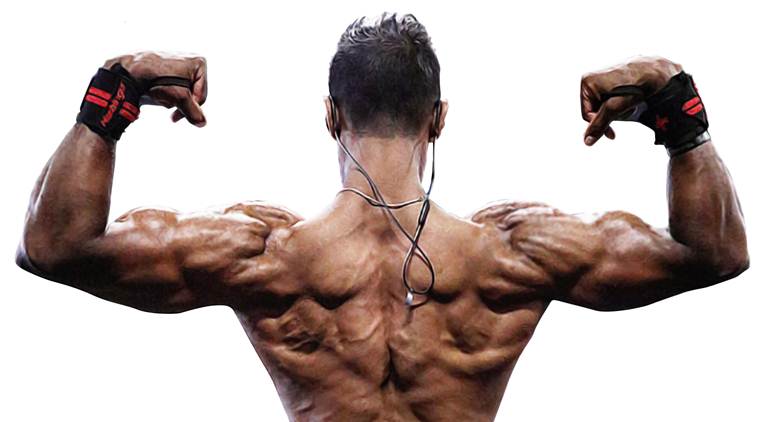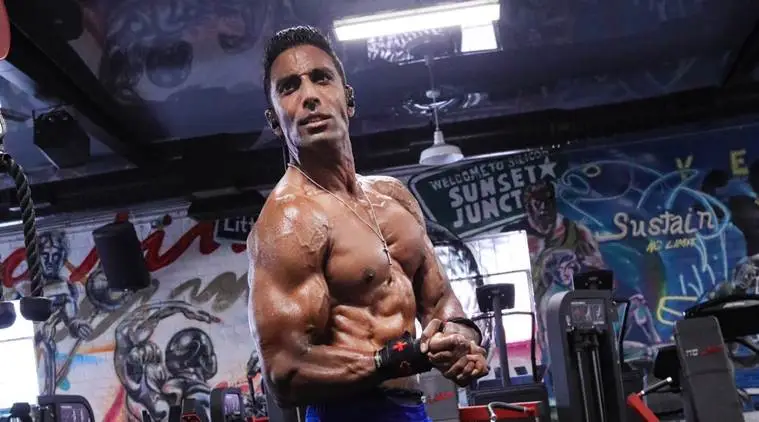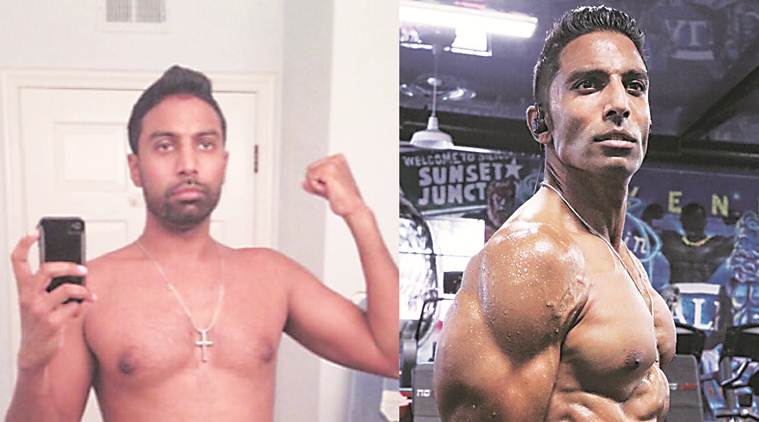
ACROSS THE world, on the other end of the phone, Prakash Amritraj talks with laboured breath. Each sentence is split by an audible and desperate gulp of air, and it doesn’t take long for him to realise this.
“Sorry,” he apologises earnestly. “Bear with me here. I’m in the middle of my first work out. I get a couple of work-outs done before I get into my day.”
He’s at a gym in Indian Wells, California, going through the first checkbox in his carefully designed morning routine. First on a list is an exercise he’s taken up recently – fasted cardio – one that was inspired by a certain Dwayne Johnson – better known as ‘The Rock.’
“Basically I’m doing lots of cardio workouts before eating anything,” he explains. “Then I eat my breakfast. Blueberries, oats… the good stuff.”
The 35-year-old has been on this journey to super-fitness since 2013. Armed with an unwavering determination, he’s seen his once skinny frame transform into a specimen that would rival the most avid of body-builders. Every pound of weight lifted at the gym is with purpose, and every morsel of food he eats is measured.

This has been the way he’s lived his life each day since he left the day job that he was well known for tennis. After going through a reconstructive shoulder surgery six years ago, Amritraj, who was once India’s highest ranked singles player, has moved on from his days of playing tennis professionally to make inroads into the realm of film production, acting, and his latest adventure: sports presenting.
The last endeavour took him to Acapulco, Mexico last week, where he watched the ATP 500 event from the sidelines and interviewed players after their matches. After one particular game, Rafael Nadal dutifully walked over to Amritraj who was waiting on the edge of the court. The Spaniard, the Hulk of the tennis world, was outsized by his interviewer.
Amritraj had on a white polo t-shirt with sleeves stretched to the max that could barely go over his biceps (“I have an exceptional tailor,” he says lightly).
“All of the players who see me now,” he says, “are amazed. They used to know me as the skinny guy on the tour. As for Rafa, my biceps are definitely bigger than his. Let’s get that clear right now.”
The last time Amritraj played a competitive tennis match was in July 2013, when he was still just 29. At the time, the former world no 154 required reconstructive shoulder surgery, but it prompted the decision from him to not get back to the tour.
“When you’re young and you don’t have much perspective, your mind is closed,” he says. “I used to think that tennis is life and life is tennis and that was it. You soon realise that you don’t think past your tennis life when you’re young, and when you’re done, you suddenly think, ‘oh wait, there’s another 70 years left in life.’”
Professionally, his tennis career was replaced by sojourns in Hollywood. But the physicality of the sport left a glaring void upon retirement.

“When you’re training eight hours a day for your whole life, a lot of your day is structured around that,” he explains. “So much of my life was based on physical pain and physical training. Everybody knows me for my work ethic and discipline. So for me to just shut that down one day, I would lose my mind. A lot of people do it with golf after tennis, some do it with poker just to put that competitive drive into something else. I could never lift weights when I was playing tennis, but I always enjoyed it. So I started getting into that.”
There’s a set of photographs Amritraj has on his phone, all split-screens of the before-and-after type. On one side, he poses topless with a touch of post-surgery weight around the midriff in a picture dated September 2013. On the right, he’s flexing his muscles as a body-builder would. A layer of sweat brings out a glow as the camera captures the bulging biceps, the chiselled torso and those hard-earned six-pack abs. The ‘after’ picture was taken in September 2018.
The work ethic with which he played his chip-and-charge game did not allow him to merely enter a gym and play the role of a trainer’s puppet. Just lifting weights to fill the void tennis had left was not going to be enough for him. He went out of the way to learn about nutrition and what all it takes to earn the body he now has, even training under the tutelage of renowned Hollywood trainer Corey Calliet – whom Sylvester Stallone once called ‘the Picasso of the body.’
“He weighs his food in the morning,” says his father Vijay Amritraj, a former world no 18 and the most decorated Indian singles player in the Open Era. “He cooks his own meals so he knows what’s going in. He takes all these meals to the various meetings that he goes to. Who does that? People who see him want to do it, but they don’t.”
So vast is Amritraj junior’s knowledge of nutrition that he asserts a number of current tour players have approached him for tips on their diet. At the same time, Prakash has also helped out a few friends of 65-year-old Vijay.
“I can write a book on nutrition now,” Prakash says. “I only wish I knew all this when I was playing. But it’s crazy that I’m eating six meals a day now, which doesn’t feel enough, and when I was playing I ate three meals a day and was full.”
The fitness regimen he has set up for himself leaves him no time for distractions, or excuses for that matter. He remembers a time last year when his presenting and commentary work needed him to cover a tour event in Beijing from the studio in the United States.
“My call time was 4:30 in the morning because of the time difference. So I was at the gym at 1:00 AM everyday.”
A phone call from India during a grinding fasted workout is easier.
In 2010, Amritraj, still 27 at the time, found that his love for the sport had started to dwindle. That an injury took him off the tour didn’t help either. But it was then that he first delved into the other passion he had known since he was a child, the art of film.
He auditioned at a Los Angeles studio run by renowned acting coach Jocelyn Jones to better learn the trade.
“That transformed my craft as an actor because you’re training with people who’ve done so much in acting,” Amritraj says. “It opened up my eyes and my perspective.”
He did return to the tour though, for one final fling two years later in August 2012. But that lasted only till July the next year when he finally called it quits at the age of 29.
“I had beaten so many players who are sitting in the top 20-30 right now and they’re all playing well into their 30s,” he says. “I could have, I should have kept going, certainly. But when I had the reconstructive shoulder surgery, I had a different perspective about everything. I thought about all of the things I wanted to do in life. I was starting from scratch in those careers. It was the right time to go ahead and chase all of that as opposed to chase all of that when I was 35-40.”
Till date, Amritraj has worked as co-producer and executive producer in Escape Plan: The Extractors and Untogether respectively – he even had an acting role in the latter. As such, he’s followed in his father’s footsteps.
Back in 1983, the senior Amritraj had played a cameo in the James Bond film Octopussy, and later had a role in the Star Trek series before getting into production and tennis commentary.
It’s also led to a few comparisons within the family.
“From the work and training I’ve done, dad says I’m a better actor,” Amritraj says. “But listen, he was in a James Bond film. You can’t argue with that.”
Father Vijay concurs: “Like his tennis, he’s worked very hard at his acting. His acting is much more educated and professional and by the book. I was exactly the opposite.”
Of late though, the younger Amritraj has been keeping busy travelling the world with his new role as tennis presenter. It’s given him the chance to visit tournaments he never got to play in, and at the same time, gave him time to tour the city.
In Acapulco last week – where he never played during his time on tour – he managed to slot a few ‘adventures’ into his schedule.
“As a player it was just courts and hotels, courts and hotels. Now I’m really trying to take in everything around the globe,” he says. “We were staying on the beach, so I did jet-skiing, ATV-riding and then, I was about 2 miles in the sky, zip-lined all the way across land and the ocean. It was incredible.”
Shortly after Indian Wells and the Miami Masters, he will travel to Europe for the clay season. And he’s already got a few things lined up on his agenda.
“In Rome I definitely want to visit the Colosseum, and Monte Carlo is right there by the water…”
These days his baggage during travel includes a nice crisp suit and “whatever (he needs) for the gym.”
Amritraj is no stranger to travelling – he’s been at it since he was a toddler when he used to accompany his father during tournaments.
“Prakash had a second passport when he was two,” Vijay recalls. “But he was well behaved during travel. He slept on the plane, if the food was late it didn’t matter. The only time he’d cry was when he had to get a shot because he was scared of the needle. Interestingly, when you have to draw blood today for a blood test, he needs you by his side. I guess the early thought process rarely leaves you fully.”
There were a few occasions though when the then baby Prakash would make his presence felt from the stands. During an exhibition match in Hong Kong when Prakash was just over a year old, he cried to see his father playing on court.
“That was against John McEnroe, and he said ‘shut up’ to the stands, and I jumped back at him saying, ‘hey, that’s my kid you’re talking to,’ and everybody had a good laugh,” Vijay remembers.
He describes another incident: “In Tokyo in the quarterfinals of the Japan Open (1984), my wife Shyamala was sitting courtside with him. She turned to talk to someone, and Prakash walked off to the middle of the court calling me in front of 8,000 Japanese and Ivan Lendl on the other side of the court. So I picked him up and pretended I was playing with him in my arms. I’ve never seen 8000 Japanese enjoy something so much. And strangely enough, that’s the first time I saw Lendl smile on court.”
By the time Amritraj senior retired in January 1993, he had won 16 Tour titles – still the record for an Asian player. He had set the bar high for any Indian singles player that followed, let alone his own son. In hindsight, Prakash asserts that there perhaps was some pressure because of his father’s legacy.
“I didn’t feel it at the time, but looking back, yeah. The minute I was born, it was announced on every piece of media you could find in the world,” Prakash says. “Anytime I did anything, the papers were all over me in a way that never would have been done if I wasn’t his son.”
Vijay remembers a Davis Cup tie in 1985 held in Bangalore against Sweden. Then less than two, Prakash had a ‘baby racquet’ and was hitting a ball along the surface to his father who would hit it back. This was moments before Vijay was to play Mats Wilander.
“Someone took a picture and ran it in the paper next day with the caption: ‘Will Prakash ever play Davis Cup for India?,’” Amritraj senior says. “20 years later India was playing Sweden in Delhi, Wilander was the captain and I was helping Prakash. They took a picture of me with Prakash at the baseline and ran a full-page of both pictures side-by-side. The caption said, ‘Amritraj Act 2.’”
Both father and son recall that picture and count it as one of their favourite moments regardless of how those Davis Cup ties ended. Prakash’s career in comparison to his father’s was much shorter, lasting only 10 years, and didn’t have any of the glittering titles Vijay captured – though he did reach the final of the ATP in Newport in 2008.
But it’s in the few moments in his career that he finds a sense of belonging, a sense of fulfilment. He recites a memory of watching his father trailing two-sets down and facing match points against former world no 10 Martin Jaite in a 1987 World Group Davis Cup tie against Argentina in New Delhi. Vijay came back to win that match in five sets.
“When we were playing Japan in 2008, I was playing Go Soeda, was trailing by two sets and facing match points, on the exact same court. And then I came back to win 8-6 in the fifth set,” Prakash says. “Those kind of moments make you feel like you’re a part of something.”
Prakash has managed to catch his breath now, as he starts preparing his breakfast. He’s learnt to multi-task now – it’s a tool that ensures nothing distracts him from his workouts. Hours later he’s expected to get to the Indian Wells courts for his presenting work.
Vijay laughs when asked what he thinks about his son’s transformation. Then he offers: “It’s possibly the first time where the interviewer is looking better than the interviewee. All of us cover ourselves with a coat and tie and I think we all look pretty good in that. But there are not many people that can wear what he wears and get away with it.”
It’s a different line of work that Prakash follows now compared to what was hoped and expected of him when played on tour. But there are no regrets.
“I feel that what I’m doing right now,” he says, “I feel that this is really what I’m meant to do.”